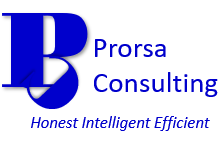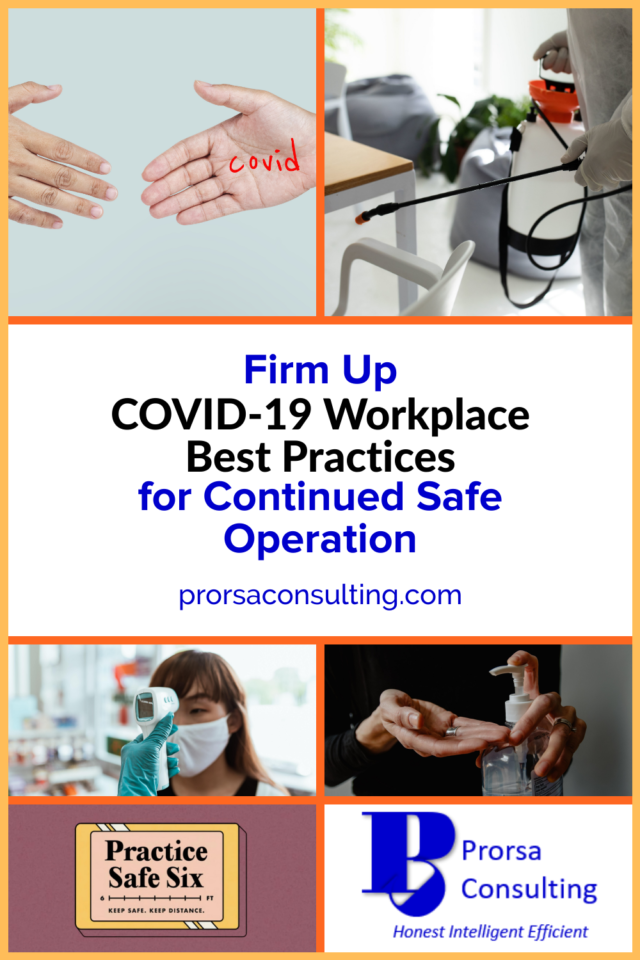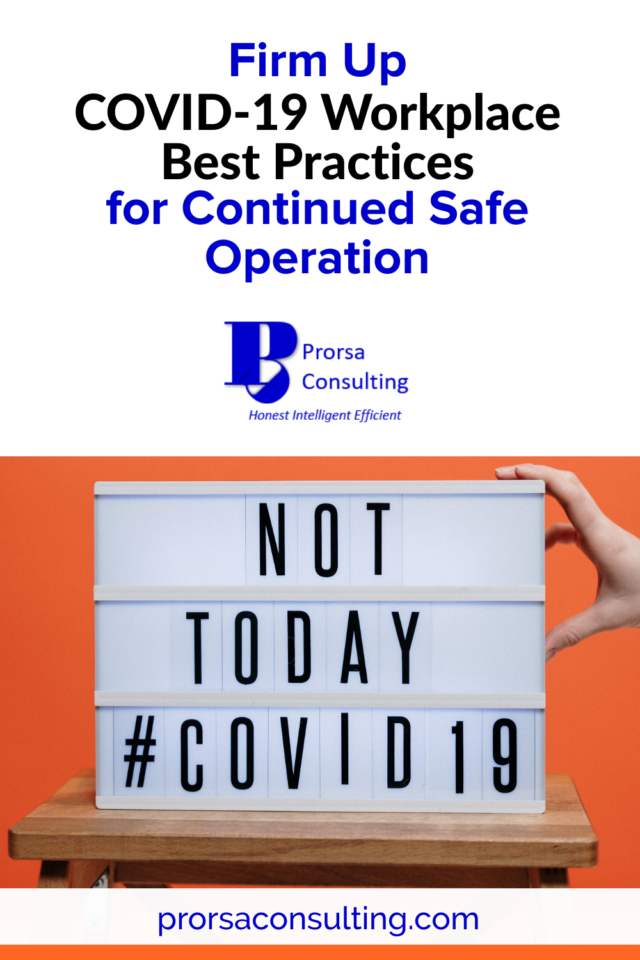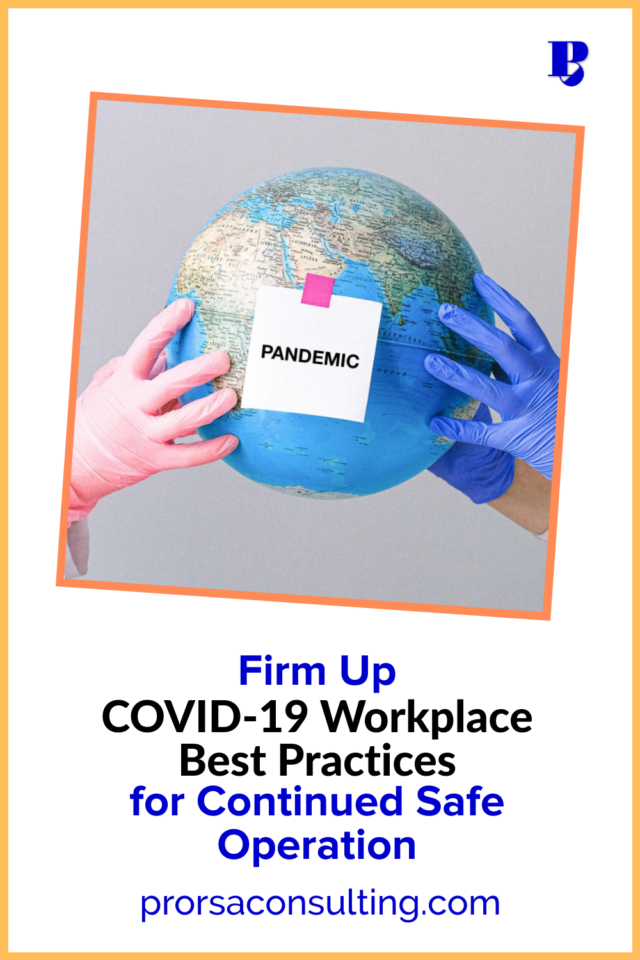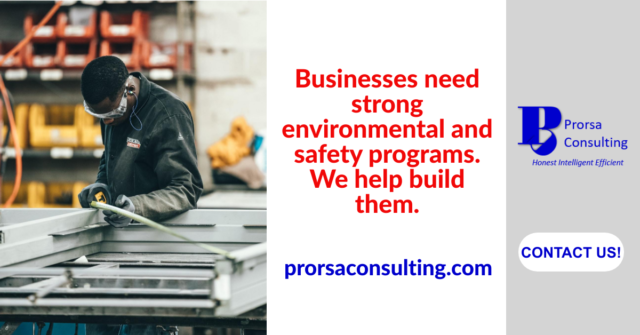Firm Up COVID-19 Workplace Best Practices for Continued Safe Operation
By : Admin -
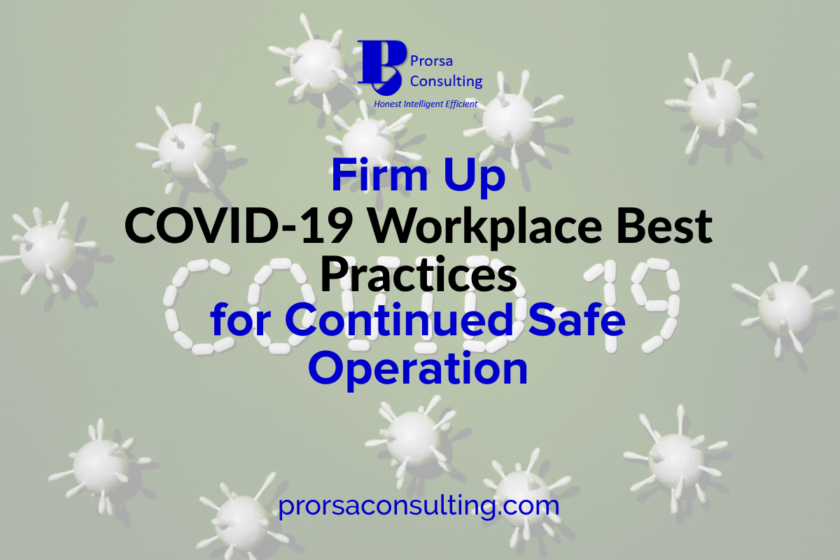
COVID-19 will be with us for the foreseeable future.
As such, businesses must keep safe operations top of mind to prevent disease spread to employees and customers. Reaffirming the commitment to COVID-19 workplace best practices serves as an excellent strategy to protect people and conduct business.
With U.S. cases on the rise again, it now presents a perfect time to review, evaluate, and update company COVID-19 preparedness plans. Keep reading below as we walk through some of the best activities to help organizations mitigate the risk of COVID-19 in the workplace.
Include Regular Employee Screening Questionnaires in the Workplace COVID-19 Protocol
Having workers routinely complete screens for COVID-19 can help employers identify potential virus carriers. If you know the persons at higher risk of carrying the virus, you can prevent them from entering the workplace and exposing others.
Keep the Screenings Simple
People can exhibit resistance to things they perceive as more ‘work’. Most workers were not performing health screenings before the pandemic, so the screens can seem like one more thing employees must do for work.
Keeping screening questionnaires simple can help deter negative employee feelings and encourage better compliance. Furthermore, consider allowing employees to complete the screens electronically via an app or online portal for even more convenience.
Be sure to incorporate some way to identify individuals who have already completed the required screen. Stickers, bracelets, or badges are just a few methods to help others know who has successful passed the screen.
At a minimum, the health screen should ask the following:
- Have you experienced a fever, sore throat, cough, muscle aches, loss of taste or smell, congestion, runny nose, nausea, vomiting, diarrhea, fatigue, or shortness of breath or breathing difficulty in the last 24 hours?
- Have you had close contact with persons showing any of these symptoms or confirmed as COVID-19 positive in the last 14 days?
- Are you or anyone living with you isolating or quarantining because of possible exposure to a person with COVID-19?
- Are you worried that you or someone else in your household may be sick with COVID-19?
- Are you or anyone living with you currently waiting on COVID-19 test results?
- Have you traveled outside the U.S.A. in the last 14 days?
The Centers for Disease Control (CDC) uses an exceptional novel coronavirus disease screening resource in its facilities for those who want an example to follow. Additionally, Space IQ has an expanded list of COVID-19 workplace questions for businesses wanting a more in-depth screen.
Screen Employees Often
COVID-19 screening only works when used frequently. Daily screening has become a reality for millions of workers. Even employees with the potential to return to offices from remote work locations have been engaging in frequent COVID-19 screens.
Screening less often than daily creates a weakness in an organization’s COVID-19 workplace best practices. This crack in defenses could allow individuals with symptoms, positive COVID-19 test results, or possible exposures from others to enter workplaces and infect unsuspecting workers or customers. Consistent, frequent screens will decrease the likelihood of potentially infected individuals from spreading the virus at work.
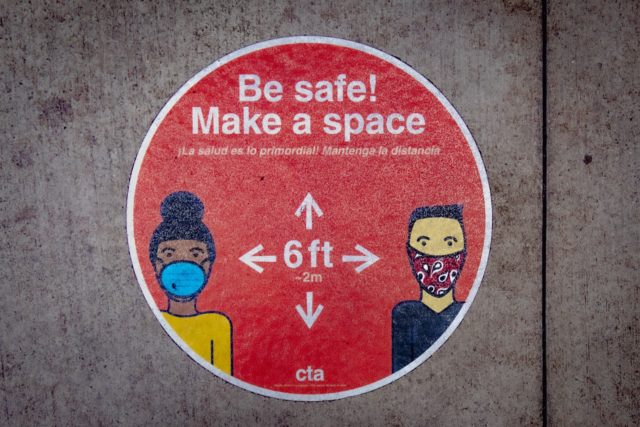
Image by Elizabeth McDaniel on Unsplash.com.
Use the Organization’s COVID-19 Workplace Guidelines to Address Shared Spaces
Over the past number of years, society has shifted to make the work experience a more collaborative one. This change has produced an increase in shared spaces in the workplace. While this scenario helps boost productivity, it can prove challenging when trying to prevent virus spread.
Utilize Social Distancing as Part of COVID-19 Workplace Best Practices
Screening provides a stellar tool to identify potential carriers of the novel coronavirus. However, it is not foolproof. Therefore, organizations must take additional precautions in the workplace to prevent exposure from those who may be asymptomatic and unaware they carry the infection.
Keeping your distance from infected persons can help to slow the spread of the virus within the population. In the workplace, various social distancing measures can decrease the potential for infection. We will cover a few of these actions below.
Social Distancing Methods for the Workplace
Keeping employees at least six feet apart presents the apparent first action employers should take to protect their workforces. Businesses should space workstations the required distance away from each other to accomplish this goal. In addition, signage, including floor tape or mats placed at appropriate distances, can be incorporated throughout the workplace as a reminder to employees.
Modifying traffic patterns throughout the workplace provides another way to keep workers separated. This method proves especially useful in highly-traveled areas where workers moving in opposite directions cannot keep six feet apart like in hallways.
Designating areas as “one-way only” traffic will allow persons to follow one at a time in a distanced manner. Furthermore, rooms with multiple points of entry can carry defined entrances and exits.
Companies should also consider alternative work arrangements in their toolboxes to keep workers socially distanced. These alternatives to the traditional ways of doing business may include remote work, virtual meetings, alternating shifts, and conference room attendees’ limits.
Many organizations have also incorporated waterproof barriers in the workplace as a means of separation between people. The barriers should inhibit the flow of air or liquid droplets from one individual to another to minimize virus spread. Also, consider warning signs to prevent individuals from inadvertently walking into a floor to ceiling barrier if the dividers are clear.
Furthermore, companies must investigate strategies to protect non-employees if operations require in-person engagement with the public. The CDC’s Interim Guidance for Businesses and Employers Responding to the Coronavirus Disease 2019 gives additional social distancing measures in the workplace, generally covering all establishments.

Image by Melissa Jeanty on Unsplash.com.
Emphasize Proper Hand Hygiene in COVID-19 Workplace Best Practices
The CDC includes proper hand hygiene as one way for individuals to protect themselves and others from the novel coronavirus. For hand hygiene to work as intended, it always needs to be practiced, including at work. As such, employers cannot neglect to address this prevention method as part of its COVID-19 preparedness plan.
Make Frequent Handwashing a Must for Workers
Near the beginning of the pandemic, I spoke to a client who told me his hands were raw from all the handwashing. I relayed to him that his handwashing frequency seemed just about right.
In reality, there is no fixed number of times per day to wash your hands for protection from COVID-19. However, workers should be encouraged to wash their hands properly at least:
- Before breaks where food or drink consumption will take place;
- After using the restroom;
- After cleaning work areas, if applicable;
- After touching joint surfaces in shared work areas (i.e., copiers, light switches, doorknobs, etc.);
- Before putting on face coverings; and
- After removing face coverings.
Furthermore, employers should reinforce proper handwashing techniques in the workplace:
- Wet hands and apply soap;
- Work the soap until it lathers and continuing rubbing hands together for at least 20 seconds, paying attention to palms, backs of hands, in between fingers, and wrists;
- Rinse hands thoroughly; and
- Dry with one-use paper towels or cloth towels laundered between each use.
Offer Alternative Means of Sanitation Between Hand Washings
Hands will inevitably collect germs between hand washings. Employees frequently touch surfaces during the day while doing their work. After all, we are talking about the workplace.
The chemicals contained in the sanitizers will not “clean” the hands because they do not necessarily remove dirt. Instead, the substances decrease the number of bacteria, viruses, and other microbes on the hand. As such, they work well in a pinch when soap and water are unavailable or inconvenient.
Employers can and should provide hand sanitizing stations to workers as part of their COVID-19 workplace best practices. The sanitizers can come in the form of a liquid, foam, or wipe.
Nevertheless, any sanitizing stations should be touchless or one-hand access (i.e., pull one wipe from the station). Also, do not forget to make waste receptacles a part of the station if needed. Alternatively, it may make better sense to supply individual hand sanitizers at personal workstations for some businesses.
Encourage Alternative Greeting Behaviors to Prevent Germ Spread
Social distancing does not give an excuse for employees to disengage. Workers still need to feel free to greet those who share their workplace. The days of shaking hands may be gone for a while, but companies can promote alternative greeting methods.
A quick elbow bump can help to prevent hand contamination. Also, a wave or thumbs up can provide a welcome while keeping one’s distance. Head nods and air high-fives can also serve as alternative means of salutation.

Image by Manny Becerra on Unsplash.com.
Promote Face Coverings For COVID-19 Exposure Prevention
The subject of face coverings has morphed into a controversial topic over the last several months in the U.S. Yet, it should not be one within the workplace. Companies should approach face coverings within their COVID-19 workplace best practices as simple means to safeguard against unwanted exposure, just like safety boots, safety glasses, or earplugs.
Masks vs. Face Coverings: Choose the Best Fit for the Company’s Safety & Health Situation
Different industries have unique safety and health hazards indicative of them. Those providing critical care to COVID-19 infected or suspected infected persons, i.e. healthcare workers, definitely need the protection of face masks meeting federal requirements. In other industries, the decision between masks or face coverings must consider the dangers present in each workplace.
If employees outside of the healthcare industry are already required to wear masks or respirators in the workplace for non-pandemic-related air hazards, then logic would dictate they continue to do so when necessary. However, employers can and should evaluate whether hazard control, as per the Hierarchy of Controls at the National Institute for Occupational Safety and Health website, is feasible and adequate to reasonably protect workers in the case of mask or respirator supply shortages.
For those businesses without mask or respirator requirements or for facility areas and tasks not covered under OSHA’s General Industry Respiratory Protection Standard, face coverings can offer increased protection from COVID-19 infection.
Train Employees to Properly Maintain and Don/Remove Face Coverings
Cloth face coverings are not classified as personal protective equipment (PPE) by OSHA. However, workers should still keep these items in good working condition for optimum effectiveness.
Face coverings should be washed frequently and can be stored in bags when not in use. Employees may follow the fabric label instructions for proper washing and drying of coverings. The CDC offers additional information on the washing, drying, and storing of cloth face coverings.
Individuals must exercise care when putting on or taking off face coverings to avoid contamination of the covers and hands. Hands should be washed before donning a clean face cover and after removing a used one. The face cover should be handled only by the covering ties, elastic straps, or ear loops when donning or removing.
Furthermore, face coverings should be worn in such a manner as to cover both the mouth and nose for the best protection. The covering should fit snuggly but comfortably on the face. Additionally, workers should also avoid touching coverings while wearing them. You can get more face covering wear tips from the CDC.
Don’t Forget Enhanced and Increased Sanitation in COVID-19 Workplace Best Practices
Another pillar of preventing virus spread entails making sure to keep frequently utilized surfaces clean. To accomplish this task, many companies have had or will need to modify their sanitation operations. Management should consider these changes when looking at a business’s overall COVID-19 response.
Work with Suppliers and Vendors You Trust
Your business does not need to buy a product or contract with a service provider and have the product or service fail to live up to expectations. As such, organizations should endeavor to work with business partners they know and trust.
Ideally, companies should capitalize on their current business relationships when sourcing for COVID-19 sanitation products and services. If your organization is already a customer, then chances are the supplier has treated you well until this point and will continue the same level of service into the future. Yet, working with existing vendors and contractors may not always be feasible.
If you need to work with a new supplier or contractor for more stringent sanitation needs due to the pandemic, stick to your normal procurement process. That way, the supplying company can be thoroughly researched and vetted before entering into a business arrangement.
Organizations should also look for products that have proper registration as a disinfectant for coronavirus from the EPA. Sanitation providers preferably would utilize these products in their services.
Moreover, companies should beware of businesses or individuals advertising themselves as “EPA-certified” or “CDC-certified” for COVID-19 disinfection or cleaning services. Ask for documentation and research the existence of any certifications claimed before agreeing to services.
Incorporate New Chemicals into the Hazard Communication Program as Needed
Due to this pandemic’s far-reaching nature, organizations may need to acquire new chemicals to combat contamination within the workplace. New chemical substances often necessitate an update to the site’s written hazard communication (HazCom) program and additional employee training.
A site’s approach to its sanitation will dictate the need for the inclusion of new products. If you decide to handle sanitation in-house using industrial-sized and labeled products, more likely than not, these substances will need incorporation into your HazCom program.
However, you may decide that employees will clean with consumer-sized and labeled chemicals you purchased at the nearest retail store. If workers will not experience exposure to these chemicals in quantities or timeframes exceeding what they usually would during regular consumer use, the substances may fall under an exemption to HazCom.
Additionally, workers will need training on the risks associated with any new substances. The employee training on the chemicals should also cover proper handling, use, storage, and required PPE.
Give Attention to Ventilation in the Fight Against COVID-19 in the Workplace
Adequate ventilation can prevent the build-up of many air contaminants within the workplace, including the novel coronavirus. As such, the establishment needs to evaluate airflow within spaces as part of the effort to maintain safe and healthy conditions.
Contact a Professional for an Assessment of Heating, Ventilation, and Air Conditioning (HVAC) Systems
HVAC experts can inspect an organization’s current systems and detect any issues that may cause problems. Additionally, these professionals have the knowledge and experience to offer solutions for any obstacles a malfunctioning HVAC system poses to a COVID-19 workplace response.
As with any other contractor or vendor, companies should ensure they are working with a competent, reputable service provider. Look for certified individuals with insurance coverage and expert experience to protect the best interests of your business.
Learn the General COVID-19 Guidelines for Workplace Ventilation
In a recent OSHA Alert, the Agency provides guidance for managing ventilation to protect against COVID-19 exposures at work. These general instructions cover topics from HVAC functionality to how to employ ventilation in the workplace. The guidelines include suggestions such as:
- Avoiding the use of personal fans that move air from one worker to the next
- Employing HVAC filters with a Minimum Efficiency Reporting Value (MERV) of 13 or more
- Ensuring exhaust air cannot re-enter buildings through air intakes or open windows
- Increasing outdoor air intake to the HVAC system and bringing in other sources of fresh air through open windows, doors, etc., when possible
- Thinking about the use of portable high-efficiency particulate air (HEPA) filter equipped devices, especially in areas of increased exposure risk
- Keeping the total HVAC system in a fully functional state
- Wearing proper PPE when changing air filtering equipment

Image by Public Domain Pictures on Pixabay.com.
Create a Plan for Your COVID-19 Workplace Best Practices
Organizations have a much better chance of accomplishing any goal when a plan exists. Trying to return to work without a COVID-19 best practices plan is like trying to build a building without a blueprint. The response effort will be uncoordinated, completely reactive, and not support the best outcomes.
Research What Measures Are Required and Work Best for the Company’s Operations
A company’s infectious disease response plan should not be one size fits all. The site-specific strategy must comply with federal, state, and local regulatory requirements. As such, programs may differ from location to location, so researching obligations would prove prudent.
Also, businesses can consider physical constraints when developing their COVID-19 response efforts. For instance, plexiglass dividers between employees on a production line pose a challenge given the equipment’s physical configuration. In this instance, social distancing and lower line speeds may prove a more feasible solution.
Furthermore, the budget must play a part in the COVID-19 best practices plan’s development. The business will reap no benefits if the agreed-upon methods cannot be put into action due to high costs. Opt for measures offering proper protection while respecting the company’s bottom line.
Capture Company-specific Measures in a Written Format
Ideas reside in individuals’ heads; an executable, written plan provides the means to be effective. Company-specific measures can lose standardization and enforceability when left undocumented.
Your organization’s infectious disease response plan can exist as a standalone procedure. As an alternative, you may choose to include it within a more extensive emergency action or preparedness plan.
Moreover, your internal document management policy should cover the written response plan. The official documented strategy should be identified as “official” and made available to employees.
The document should undergo periodic review for completeness and accuracy. Moreover, any needed changes to the COVID-19 best practices plan outside of the systematic review should undergo internal discussion and management approval.

Image by Jason Rosewell on Unsplash.com.
Communicate as if Lives Depend on It Because They Do
A written plan sitting on a shelf cannot serve its purpose if it goes uncommunicated. People need factual information to protect themselves during any pandemic. Thus, the business’s COVID-19 communications should be top-notch to ensure all those involved stay informed.
Make Frequent, Ongoing Communication Part the COVID-19 Best Practices Strategy
Adults usually need to hear a message on several different occasions to assimilate the information. With information as necessary as coronavirus exposure prevention strategies, consistent, regular communication is prudent.
To make this task manageable, integrate COVID-19 messages into your routine communications. Options include adding a coronavirus protection tip to your email signature or having supervisors start toolbox talks with a brief COVID-19 update. Furthermore, a daily update posted to the company’s intranet site or the texting of quick tips to company mobile devices may prove useful.
Ongoing reminders outside of formalized training afford extra opportunities to impart knowledge to workers. So, do not expect communication to be a one and done activity. More frequent communication helps to keep employees engaged in the process for the long haul.
Provide Variety in the Formats Individuals Can Use to Access the Information They Need
Workers come in all shapes, sizes, and mindsets. It is unreasonable to assume all employees will accept a message the same way regardless of the format. That supposition simply defies logic.
Businesses should offer communications in a variety of formats to provide choice to workers. Employees will be more apt to seek the information they need when messages reside in a structure comfortable to them.
Some individuals are okay with a presentation layout. However, other persons would prefer to read their updates. Another group may get the most impact from an audio or video message.
Furthermore, messages may need to be developed in multiple languages for optimum effectiveness.
The worst messages create roadblocks to the audience’s understanding and acceptance, which can happen when communication gets delivered in a non-preferred format. As such, organizations should tailor their information delivery for COVID-19 workplace best practices to suit the workforces’ needs and preferences.
Related Workplace Best Practices Posts for You
Performing a Job Hazard Analysis: Your Powerful Weapon to Prevent Workplace Injuries
Final Thoughts
Implementing an infectious disease response plan is an ongoing endeavor. Even if your facility has a strategy in place to control the potential for workplace coronavirus exposure, you still need to check to ensure your COVID-19 best practices plan works.
The information provided throughout this article can serve as a simple framework to assess an existing program. It also provides an initial roadmap for facilities that have yet to reopen but plan to do so soon.
Maintaining health and safety during a pandemic can be done. However, it does take proper knowledge, planning, resources to implement appropriate COVID-19 workplace best practices.
We encourage your feedback on this blog. Be sure to like, comment, and share below. You can also provide feedback via our Contact Us page. Also, don’t forget to follow Prorsa Consulting on LinkedIn, Pinterest, and Twitter.
Prorsa Consulting works with regulated businesses to assess, maintain, and improve environmental and safety compliance to lower business risk. Click on the banner below to start working with us by scheduling a complimentary discovery call.
How would you like to have access to additional, exclusive EHS updates & info from Prorsa Consulting? Just signup for the Prorsa Consulting Newsletter below. You’ll get access to our Free Resources area and all the tools, templates, and presentations in the library. Get your free subscription today!
